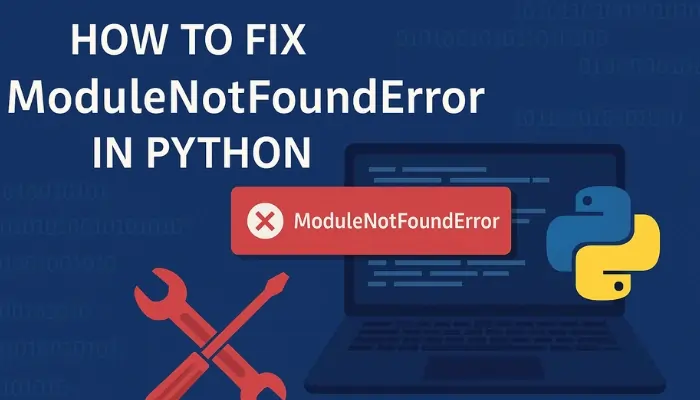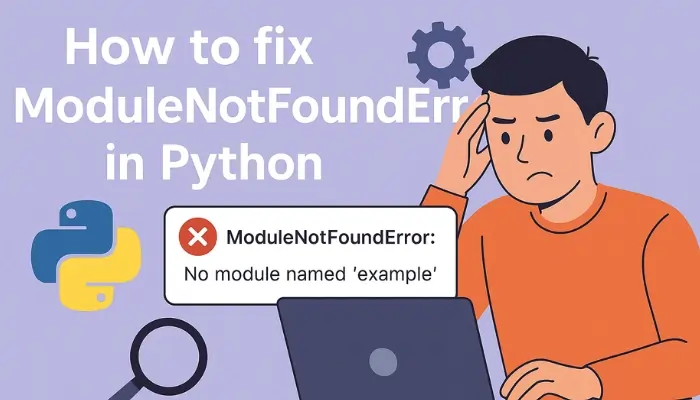Quick Fix:
If you are facing an error in modulenotfounderror Python, try these quick solutions:
- Install the missing module:
pip install module_name - Check for typos in the import statement:
- Wrong: import nump
- Correct: import numpy
- Verify Python environment:
- If using a virtual environment, activate it first:
- Then reinstall the module.
source venv/bin/activate # macOS/Linux
.\venv\Scripts\activate # Windows - Use the correct Python version:
python3 -m pip install module_name # Force Python 3- Check if the module is installed:
pip show module_nameIf these don’t work, keep reading for detailed fixes!

Understanding ModuleNotFoundError in Depth
The ModuleNotFoundError The error you’re facing is the most common module-import-related error in Python. This error indicates that there is a problem locating the module you are trying to import. Let us examine each cause that leads to this problem.
1. The Package Isn’t Installed
Root Cause: of ModuleNotFoundError
Python can only import the modules that are present in its ecosystem. So, if you haven’t installed the module you want to import, Python will throw an error.
Technical Details
- Python checks installed packages in:
- Site-packages directory (
/path/to/python/site-packages/) - User-specific installation locations
- Site-packages directory (
- If your desired module is not present in this directory, you will face an error.
Real-World Scenarios
- Trying to use numpy without installation
- Assuming pre-installed packages exist in a fresh Python install
- Using third-party packages from PyPI without
pip install
Diagnosis
pip list | grep module_name # Linux/Mac
pip list | findstr module_name # Windows
2. Wrong Python Environment in ModuleNotFoundError
Root Cause:
Modern Python uses multiple environments to execute your programs, like system Python, Virtualenvs, or Conda etc. This error can occur even if you have installed the module, as the module might be installed in one environment but not in the one that you are using.
Technical Details
- Each environment maintains its own:
- Python executable
- Site-packages directory
- Path configuration
- Common environment types:
- Virtual environments (venv, virtualenv)
- Conda environments
- System-wide installations
Real-World Scenarios
- Installing a package globally but running in a virtualenv
- Using Ian DE-configured Python interpreter, different from the terminal’s
- Conda environment without required packages
Diagnosis
which python # Shows active Python path
pip -V # Shows which Python pip is installing
3. Typo in Import Name
Root Cause:
Make sure to type the correct name of the package you want to install, as Python imports are case-sensitive and must match the exact name of the package; otherwise, you will face an error.
Common Mistakes:
- Incorrect Spellings (numpay instead of numpy)
- Canalization errors (Pandas instead of pandas)
- Incorrect submodule paths
Technical Details
- Python’s import system performs exact string matching
- Some packages use unconventional naming:
- Pillow package is imported as PIL
- python-dateutil vs dateutil in imports
Real-World Scenarios
- import sklean instead of import sklearn
- from datetime import datetime vs
importdatetime - Confusion between package name (PyPI) and import name
Diagnosis
help('modules') # Lists all available importable names
4. Module Not in Python’s Search Path
Root Cause of ModuleNotFoundError:
When we give an import command to Python, it generally looks for modules present in the directories listed in sys.path. Your module is not listed in it, Python will fail to import the module, and hence lead to a ModuleNotFoundError.
Technical Details (ModuleNotFoundError)
- sys.path is located at:
- Current working directory
PYTHONPATH(mentioned in the system environment variable)- Default paths depending on the module installation locations
- Path search order matters (The module that matches first will be imported)
- If you want to import custom modules, you have to provide proper parameters to Python.
Real-World Scenarios (ModuleNotFoundError)
- Trying to import from sibling directories
- Working with user-made modules
- The package is installed in a non-standard location
Diagnosis
import sys
print(sys.path) # Shows current search paths
Complete Solutions for ModuleNotFoundError
If you want a more detailed solution to your problems, just follow along, where I have discussed the basics of this error and how importing modules works in Python.
1. Proper Package Installation
Basic Install
pip install module_name Pip is the most basic and reliable way to install a Python package. It downloads the latest versions of the packages from PyPI (Python Package Index), and it by default installs the packages where your Python can easily find them.
When to use:
Always try this first when you see it ModuleNotFoundError
Installing Specific Versions
If you want to install any specific version of the module, you can use
pip install module_name==1.2.3 Why would you need the exact version?
- Your code only works with that version
- Newer versions might be buggy or break your program
- Your team requires consistency
Pro tip:
You can find version numbers on PyPI or in your project’s requirements.txt
User-Only Installation
pip install --user module_name Use this when:
- You don’t have admin permissions for the computer
- You only want to install the module on one user account
- You’re working on a shared system
Note:
Doing this will install he package in your user directory instead of system-wide.
Installing from requirements.txt
pip install -r requirements.txt This is a file that lists all packages your project needs. It’s great because:
- Everyone on your team will get the same file
- You can reinstall all the packages later from this file
- This file makes the deployment of the project much easier
2. Setting Up Virtual Environments
Why Virtual Environments Matter
Virtual environments help in keeping your projects separate and clean from each other:
- Using a Virtual environment lets different projects use different packages.
- Venvs give us a cleaner and organized workspace to develop.
Creating and Using Virtual Environments
python -m venv myenv # Create
source myenv/bin/activate # Linux/Mac
myenv\Scripts\activate # Windows - After activation, install packages inside it.
Deactivate When Done
deactivate - Exits the virtual environment.
3. Understanding Python Paths(ModuleNotFoundError)
A Python developer needs to know how and where Python stores all of its modules, to be one with the language.
Where Python Looks for Modules
import sys
print(sys.path) - Shows all folders Python checks for imports.
Add a Custom Path Temporarily
import sys
sys.path.append('/path/to/module') - Useful if your module is in a non-standard location.
- Only lasts for the current session.
Important notes:
- This change only lasts until you close Python.
- For permanent changes, modify the
PYTHONPATHenvironment variable. - Be careful with path order – Python uses the first match it finds
Advanced Troubleshooting for ModuleNotFoundError
If you are still facing the problem, you can try these advanced methods:
1. Dealing with Multiple Python Versions
The Problem:
Most of us have multiple Python versions installed on our machines (Python 2.7, Python 3.6, Python 3.9, etc.).
If this is the case, your packages might be installed on one version but not on another which you might be using at the time.
How to Check
which python # Linux/Mac - shows which Python is being used
where python # Windows - shows all Python installations
python --version # Check the versionThe Solution
python3 -m pip install module_name # Specifically for Python 3
python3.9 -m pip install module_name # For Python 3.9 specifically2. Reinstalling Problematic Packages
You can always reinstall some packages that might be causing this problem to occur.
When to do this:
- When you have installed a package, but your Python is unable to import it
- When you are presented with weird or unreadable errors
- When the package you installed was not installed correctly before
How to do it:
pip uninstall module_name # First remove it completely
pip install --no-cache-dir module_name # Fresh install without using cache3. Development Mode for Local Packages
If nothing works, you can go into developer mode to use your package:
What It Does:
It installs the package in “development mode” (also called “editable mode”) where:
- You can edit the code of the package that you have installed (Only do this if you know what you are doing).
- The changes you make will be visible immediately without any refreshing or reinstalling the modules.
How to Use It:
pip install -e /path/to/packageConclusion: You’ve Conquered ModuleNotFoundError!
By following this guide, you have acquired essential skills which will help you solve these types of problems in the furutre. Here’s what you’ve accomplished:
Now you can:
✅ Fix missing packages fast
✅ Solve environmental issues
✅ Master tricky imports
Why This Matters:
This guide didn’t just provide you with some quick fixes but also taught you some very essential skills that will:
• Make your development environment more reliable
• Help you collaborate better with other developers
• Now you make new projects instead of just staring at VS Code for hours.
Final Thought:
Every error you solve makes you a better and more refined developer. Now bookmark this guide for modulenotfounderror, share it with others, and keep building amazing things.
Happy coding
Explore more on techonboom

